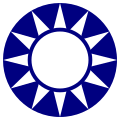One China with respective interpretations
| Part of a series on |
| Conservatism in Taiwan (Republic of China) |
|---|
 |
| One China with respective interpretations | |||||||||
|---|---|---|---|---|---|---|---|---|---|
| Traditional Chinese | 一個中國各自表述 | ||||||||
| Simplified Chinese | 一个中国各自表述 | ||||||||
| |||||||||
One China with respective interpretations (Chinese: 一中各表; pinyin: Yīzhōng Gèbiǎo; Wade–Giles: I1-chung1 Ko4-piao3) or one China, different interpretations is one of the discourses on cross-strait relations, proposed by the Kuomintang (KMT). It originated from the Kuomintang-led Republic of China's Guidelines for National Unification Program, which argued that the two sides of the Taiwan Strait are one China and two political entities, and that the Republic of China and the People's Republic of China can each express their own representation of China. "One China with respective interpretations" was not accepted by the Chinese Communist Party (CCP)-led People's Republic of China, which considered it insufficient to reflect the spirit of "the two sides of the Taiwan Strait jointly seeking national unification" (两岸共同谋求国家统一).
During the 1992 Hong Kong talks, representatives from both sides of the Taiwan Strait negotiated in the name of the private sector, and the two sides did not issue a joint declaration, but recognized their respective expressions of the "One China" issue through an exchange of letters. In 1995, Jiao Renhe, Deputy Secretary General of the Straits Exchange Foundation (SEF) of the Republic of China (ROC), for the first time summarized the conclusions of the Hong Kong meeting with the phrase “one China, each side's own expression” (一个中国). Between 1996 and 2000, officials of the People's Republic of China (PRC) repeatedly argued that this statement was incorrect, and that the consensus of the Association for Association for Relations Across the Taiwan Straits (ARATS) and the Straits Exchange Foundation (SEF) was not; according to them: the consensus between the SEA and the SEF was not that "the two sides could henceforth speak their own words on 'One China'".
After 2000, this statement was often replaced by the term "1992 Consensus, with the KMT using the "One China with respective interpretations" as the basis for its assertion of the 1992 Consensus. The Chinese mainland has repeatedly claimed that the 1992 Consensus should not only be interpreted as the "One China with respective interpretations" but also includes the requirement that “both sides of the Taiwan Strait work together to seek national unification".[1]
History
[edit]The government of the Republic of China began informal negotiations with the government of the People's Republic of China through various channels when Lee Teng-hui was ROC president.
On August 1, 1992, the National Unification Council of the ROC made a resolution on the meaning of "One China", stating:
Both sides of the Taiwan Strait adhere to the principle of One China, but the meanings given to it by the two sides are different. The Chinese Communist authorities believe that one China means the People's Republic of China, and that after reunification, Taiwan will become a special administrative region under their jurisdiction. The Taiwanese side, on the other hand, believes that one China should refer to the Republic of China (ROC), which was founded in 1912 and whose sovereignty extends to the whole of China, but whose jurisdiction at present extends only to Taiwan, Penghu, and Jinma. Taiwan is certainly a part of China, but the mainland is also a part of China.[2]
In October 1992, the SEF and the Association for Relations ARATS, which represent the governments of both sides of the Taiwan Strait, held their first talks in Hong Kong. After the 1992 meeting, Taiwan considered that the consensus reached at the meeting was that each side of the Taiwan Strait could claim sovereignty over China, and that the two sides could express this on their own, but that the issue could be set aside in the consultations. The Taiwan media considered this consensus to be in line with the resolution of the National Reunification Commission, and described it as "each claiming one China". In 1995, SEF Secretary-General Jiao Renhe formally summarized the conclusion with the phrase "One China with respective interpretations".
In 1996, following Third Taiwan Strait Crisis, the People's Republic of China (PRC) officially expressed its opposition to the phrase "One China with respective interpretations", and in 1999, following President Lee Teng-hui's proposal for a "Special state-to-state relations", the PRC reinforced its opposition to the phrase "One China with respective interpretations" as aimed at rationalizing the two-nation theory. The Government of the People's Republic of China believes that the consensus reached at the 1992 talks was that both sides would verbally adhere to the one-China principle, but that they could refrain from discussing the issue in their transactional consultations. The Government of the People's Republic of China insists that cross-strait negotiations can be conducted only on the premise of "one China".
In 2000, the ROC changed political parties and Chen Shui-bian, the candidate of the Democratic Progressive Party (DPP), was elected President of the Republic of China and gained power. While in office, the ruling president Chen Shui-bian, did not recognize the existence of the 1992 Consensus and the "One China with respective interpretations" and believed that accepting "One China" was tantamount to surrendering to the PRC. Although the government of the People's Republic of China has adopted a more ambiguous approach to negotiating cross-strait relations, its three-paragraph approach to international propaganda - "There is only one China in the world, Taiwan is a part of China, and the government of the People's Republic of China is the sole legitimate government representing the whole of China" (世界上只有一个中国,台湾是中国的一部分,中华人民共和国政府是代表全中国的唯一合法政府) - will result in the ROC regressing from its current status of being unknown to one of recognizing itself as belonging to the "People's Republic of China". The ROC will regress from its current status of uncertainty to recognizing itself as part of the PRC in terms of international propaganda.
On June 20, 2000, after assuming the presidency, Chen Shui-bian said in his first international press conference:
If there is a "consensus", it should be the "verbal expression of each side of the one China", but the other side of the Taiwan Strait thinks that there is no such consensus, so if there is a "consensus", it is a "consensus" without consensus. Therefore, if there is a "consensus", it is a "consensus" without consensus, the so-called "AGREE TO DISAGREE".[3]
On March 26, 2008, President Hu Jintao of the People's Republic of China held a telephone conversation with U.S. President George W. Bush. According to an English-language press release issued by Xinhua afterward, Hu Jintao said:
He said it is China's consistent stand that the Chinese Mainland and Taiwan should restore consultation and talks on the basis of "the 1992 consensus," which sees both sides recognize there is only one China, but agree to differ on its definition.
The phrase "both sides recognize that there is only one China, but agree to differ on its definition" has been interpreted by the Ma Ying-jeou administration in ROC as "One China with respective interpretations".[4] In 2015, President Ma Ying-jeou of the ROC stated that the China in "One China with respective interpretations" refers to the ROC.[5]
In 2016, Taiwanese singer Tzuyu raised the flag of the Republic of China, which was reported by Huang An as supporting Taiwan independence, as the Tzuyu Flag Incident. Tzuyu later released a film apologizing and claiming to be 'Chinese'. Jason Hu, the main committee member of the KMT presidential candidate's campaign headquarters, considered Tzuyu, who was born in Taiwan, holding the flag of the Republic of China to be a typical example of the One China with respective interpretations.[6]
See also
[edit]- One nation, two states
- Mutual non-recognition of sovereignty and mutual non-denial of authority to govern
References
[edit]- ^ "港媒解密九二共識 中共曾公開反「一中各表」至少12次". 自由時報. 2015-11-13. Archived from the original on 2024-05-04. Retrieved 2024-04-14.
- ^ "海協就所謂"九二香港會談基礎問題"發表談話,人民網,2004年11月14日". Archived from the original on 2015-11-21. Retrieved 2015-10-07.
- ^ "總統六二O記者會答問實錄". Office of the President (Taiwan). 2000-06-20. Archived from the original on 2022-07-26. Retrieved 2022-06-11.
- ^ "马英九:新华社英文稿"一中各表" 对两岸发展有正面意义,聯合早報,2008-03-29". Archived from the original on 2012-08-16. Retrieved 2015-12-27.
- ^ 尹俊傑 (2015-09-29). "總統:一中各表 指的就是中華民國". 中央社. Archived from the original on 2015-10-11. Retrieved 2015-10-09.
- ^ "胡志強:周子瑜拿國旗是一中各表". 中時電子報. 2016-01-18. Archived from the original on 2016-01-18. Retrieved 2016-01-18.

